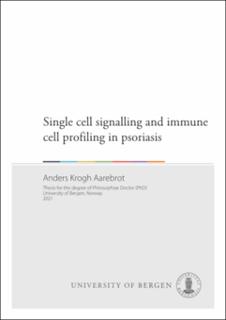| dc.contributor.author | Aarebrot, Anders Krogh | |
| dc.date.accessioned | 2021-02-16T08:34:36Z | |
| dc.date.available | 2021-02-16T08:34:36Z | |
| dc.date.issued | 2021-02-19 | |
| dc.date.submitted | 2021-01-25T14:33:09.944Z | |
| dc.identifier | container/25/e2/db/f8/25e2dbf8-f1b4-4c89-8341-8fd91a54d090 | |
| dc.identifier.isbn | 9788230859766 | |
| dc.identifier.isbn | 9788230868935 | |
| dc.identifier.uri | https://hdl.handle.net/11250/2728247 | |
| dc.description.abstract | Psoriasis is a common, chronic inflammatory skin disease with associated autoantigens, autoantibodies, local and systemic inflammation, and systemic comorbidities, such as cardiovascular disease and metabolic syndrome. Patients with severe disease often need biological treatment targeting the cytokines tumour necrosis factor (TNF), interleukin (IL)-12/23 or IL-17. The lack of precise laboratory analyses to aid selection of drug and monitor treatment effect along with adverse events and loss of treatment efficacy in a significant proportion of patients treated with biological drugs generate a need for robust assays used for monitoring and predicting treatment outcome.
The overall aim of this thesis was to analyse peripheral blood immune cells during active inflammation and treatment with biological drugs and to identify diseasespecific immune profiles and biomarkers. In study I and II phospho-specific flow cytometry and mass cytometry were used, respectively, to study phenotypes and function of peripheral blood mononuclear cells (PBMCs) from healthy controls and patients on steady treatment with infliximab (IFX), a TNF inhibitor, and to examine the impact of switching from originator IFX to biosimilar CT-P13. In study III, mass cytometry was exploited to analyse PBMCs from healthy controls and patients starting biological treatment with emphasis on the T cell lineage and its intracellular signalling. In all studies, clinical and standard laboratory parameters were incorporated in the analyses.
In study I and II, increased phosphorylation levels in PBMCs were detected in psoriasis patients compared to healthy controls. The phosphorylation levels decreased during continued treatment, without completely normalising, despite clinical remission. Specifically, in study II, psoriasis patients had higher expression of CD38 in NK and CD4+ T effector memory cells. In neither study I nor II any obvious differences were seen comparing originator IFX and CT-P13, with respect to cell frequencies, phosphorylation levels, clinical or laboratory data.
Study III revealed a shift from helper T (Th)1 to Th2 cells, a transition from naïve/effector to memory predominance, reduction of circulating Th17, Th22, Th9 and CD8+ T cells and enhancement of inhibitory programmed cell death protein 1 (PD-1) expression on T cells after onset of treatment with a TNF-, IL-12/23- or IL-17 inhibitor. Also, the monocyte compartment showed changes favouring reduced cardiovascular risk after treatment onset. Intracellular phosphorylation was higher in psoriasis patients compared to healthy controls and non-responders to treatment compared to responders.
In conclusion, multiple aberrancies were seen in cellular frequencies in patients before treatment with biological drugs. In both untreated patients and patients on originator IFX and biosimilar CT-P13, our findings support a more activated state of PBMCs. These findings provide evidence for an ongoing systemic inflammation both with and without biological treatment, implying an increased risk of comorbidities, such as cardiovascular disease. Further research will help to shed light on the role of PBMCs as potential reporters used for personalised treatment both with regards to the skin disease itself but also the long-term risk of comorbidities. | en_US |
| dc.language.iso | eng | en_US |
| dc.publisher | The University of Bergen | en_US |
| dc.relation.haspart | Paper I: Aarebrot, A., Solberg, S., Davies, R., Bader, L., Holmes, T., Gavasso, S., Bryceson, Y., Jonsson, R., Sandvik, L. and Appel, S. (2018), Phosphorylation of intracellular signalling molecules in peripheral blood cells from patients with psoriasis on originator or biosimilar infliximab. Br J Dermatol, 179: 371-380. The article is available in the main thesis. The article is also available at: <a href="https://doi.org/10.1111/bjd.16269" target="blank">https://doi.org/10.1111/bjd.16269</a> | en_US |
| dc.relation.haspart | Paper II: Anders K. Aarebrot, Irene Sarkar, Richard Davies, Roland Jonsson, Lene F. Sandvik, Silje M. Solberg and Silke Appel, Mass cytometric analyses of peripheral blood mononuclear cells from psoriasis patients on anti-TNF treatment. Not available in BORA. | en_US |
| dc.relation.haspart | Paper III: Solberg, S., Aarebrot, A., Sarkar, I., Petrovic, A., Sandvik, L., Bergum, B., Jonsson, R., Bryceson, Y. and Appel, S. (2020), Mass cytometry analysis of blood immune cells from psoriasis patients on biological therapy. Eur. J. Immunol.. The Accepted Author Manuscript is available in the main thesis. The article is also available at: <a href="https://doi.org/10.1002/eji.202048857" target="blank">https://doi.org/10.1002/eji.202048857</a> | en_US |
| dc.rights | In copyright | |
| dc.rights.uri | http://rightsstatements.org/page/InC/1.0/ | |
| dc.title | Single cell signalling and immune cell profiling in psoriasis | en_US |
| dc.type | Doctoral thesis | en_US |
| dc.date.updated | 2021-01-25T14:33:09.944Z | |
| dc.rights.holder | Copyright the Author. All rights reserved | en_US |
| dc.description.degree | Doktorgradsavhandling | |
| fs.unitcode | 13-25-0 | |
